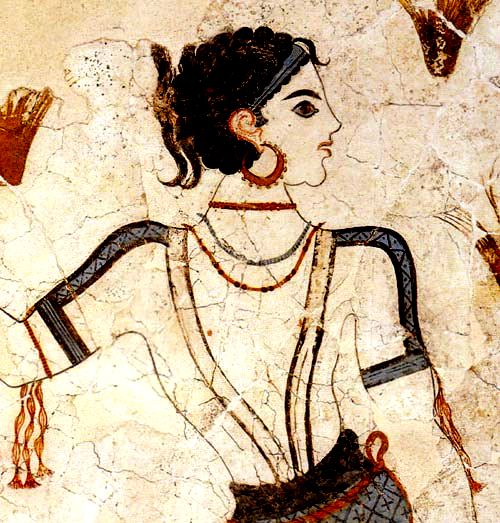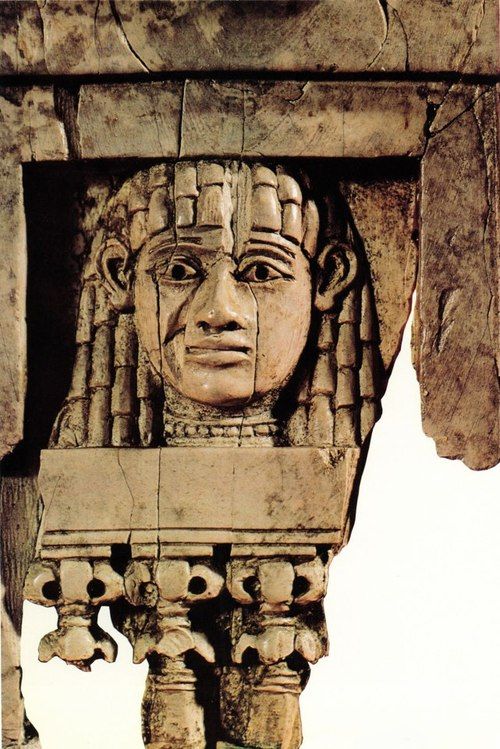THE WHITE RACES OF ANCIENT AFRICA
From
It Began in Babel
by Herbert Wendt
(1958)
|
The Cro-Magnon race, whose colourful cave-paintings in southern French and northern Spanish caves are universally admired as the first documents of the human creative spirit, spread over the whole of north and middle Europe in various migrations about twelve to fifteen thousand years ago - Herbert Wendt
Ethnologists frequently refer to Mesolithic Age Africa as ‘white’ Africa, and surmise that European man must at that time have occupied a large part of ‘black’ Africa - ibid |
|
|
|
Phoenicians
Three hundred and fifty years later the Greek historian Polybius took part as war correspondent on the Roman side in the siege and destruction of Carthage. He discovered the archives, took possession and made full use of them, informing his contemporaries that the Carthaginians (Phoenicians) ‘had once possessed the whole of Africa.' Libya, an Advanced Civilization The oldest of these finds date from the Mesolithic Age. The latest from the beginning of the Bronze Age. These prove that for several thousand years an early, highly developed culture was in existence in the region of the Sahara, similar to the early cultures of western and southern Europe and of the Near East - to all appearances a matriarchal culture. Mills and millstones, cross-axes, stone rings and digging-sticks, stone arrowheads, traces of prehistoric cultivation and nomadic pastoral economy reveal how Cro-Magnon man lived in North Africa at that time. He erected megalithic structures, worshiped female deities and evolved a matriarchal form of society. The aboriginal inhabitants of the Sahara, the ancient Libyans, the Berbers - blond, blue-eyed people with almost square faces - were true children of the Capsian culture. ‘Because of the excellence of the soil, its fine horses and wealth of all the fruits of the earth, Cyrene grew to be a great harbour city. Many remarkable men lived here, men worthy of the defence of freedom against the neighbouring barbarians. Philosophers, mathematicians, poets and grammarians belonged to their number, all honoured by the Egyptian kings.’ The Grecian chronicler did not mention that numerous scholars belonged to the academy of Cyrene, who devoted themselves to the study of the North African races. Cyrene became one of the leading centres of ancient ethnology – (Wendt quoting Herodotus) Interested travelers in Africa could converse there with all kinds of native peoples, with Hellenic settlers and traders, Egyptian priests and hand-workers, Jewish and Syrian immigrants, Libyan farmers and dark-browed nomads from the oases of the Sahara. Cyrene was a first-class center of news and information, a meeting-place of the most varied peoples, races and cultures. The Berbers make their appearance everywhere in ancient writings as Nasamonians, Tehennu, Atalantans, Getulians and Maurusians, and always as highly civilized, warlike people, well-informed about their native land. The Phoenicians and Egyptians had contacts with them. The Carthaginians and Romans tried to colonize their territories. Finally, in two great invasions, in the seventh and eleventh centuries ad, the Arabs overran them and practically wiped out the old Berber kingdom. Berbers The Romans called them ‘Barbari,’ and to-day they are still called Berbers. Sahara as Fertile At that time this was only possible if the Sahara had still not taken on the character of a murderous, waterless waste. It must once have been a fruitful savannah land, rich in trees and wildlife. That this was at least the case in prehistoric times has been proved by recent researches in North Africa. Oswald Spengler, Leo Frobenius and others accept that about the fourth millennium BC the country began to change into a wilderness; the change went on slowly and steadily but even in the second millennium BC, at the height of the ancient Berber civilization, the change was not yet complete. Devastation of the Sahara Herodotus calls the Sahara ‘a frightful wasteland, where neither water nor vegetation nor animals are to be found, a land without any drop of moisture in it’. Light-Skinned Natives In the Neolithic Age, in which the Saharan cultures came into being, we find an even more favorable picture. The whole of North Africa was populated by huge herds of animals and covered with trees and grassy steppes, in which a nomad race with light skins, able to read and write, and gaining a living by fishing and hunting, have left us innumerable memorials of their culture. Irrefutable Proof The French explorers Henri Lhote and Monsieur Dalloni discovered pillars, pyramids and rock-inscriptions in widely separated regions of North Africa. The Germans Leo Frobenius, Hugo Obermaier and Hansjoachim von der Esch investigated in the Hoggar and Tibesti massifs innumerable drawings of men and animals which are of an astounding realism. The Egyptian Hassanein Beyand the Hungarian L. E. Almasy finally brought together such a wealth of proofs relating to the primitive Saharan cultures that several scholars in their enthusiasm went so far as to claim that the cradle of humanity must have been in North Africa. They found paintings and drawings in which clearly recognizable bush and savannah animals are depicted, giraffes, elephants, rhinoceros, buffaloes, antelopes, lions and ostriches. The hot rock is covered also with pictures of war-chariots, of archers, swimmers, masked wizards, dancers and spectral, gigantic hands. Remains of megalithic structures were found, as well as stone memorials to the dead, cavern graveyards and mounds, ancient granaries and citadels that were constructed, without mortar, of enormous blocks of stone. In the various archaeological layers were metal ornaments, glass, pearls, leather, terracotta ware, clay pots and drums, but most important of all there were the fertility symbols, statues of the Great Mother, a female figure holding her breasts with both hands. Matriarchal Tribes The Berbers inherited this Sahara-culture. They, too, had a matriarchal form of society right up to the times of the Carthaginian, Greek and Roman colonizations. Herodotus’ references to ‘Libyan Amazons’ and Diodorus’ long report on various races of war-like women in Libya are proofs of how strange the Greeks found the remains of the ancient matriarchal system. These ancient matriarchal societies do not seem to have succumbed to the Europeans; on the contrary, everything seems to indicate that the Berbers of the primitive Sahara took over and developed the oldest culture in Europe, the culture of Cro-Magnons of the Late Ice Age. Cro-Magnon (Whites) The Cro-Magnon race, whose colorful cave-paintings in southern French and northern Spanish caves are universally admired as the first documents of the human creative spirit, spread over the whole of north and middle Europe in various migrations about twelve to fifteen thousand years ago. They covered the greater part of Asia and later even spread to wide areas in America. But one branch of the race remained in Spain, and from there Cro-Magnon men went to settle in the regions of the Atlas Mountains, and in the course of the Mesolithic Age they also appeared in what were then the savannah lands of the Sahara. Berbers Originally White In the neighborhood of the Algerian town of Mechta the skeletons of the original inhabitants of the Sahara have been dug up. These Mechta men were tall, long-limbed and big-boned, they had a high-domed skull, a broad face and a prominent jaw. Their relationship with the Cro-Magnon race is unmistakable, as well as their resemblance to the original Berbers, before these were altered by admixtures of Arab and Negro blood. According to authoritative writers on pre-history, the Cro-Magnon men must have been blond and blue-eyed. The fair-skinned Libyans depicted on ancient Egyptian monuments are also blond and blue-eyed; among the Berbers in the Atlas region there are still blond Cro-Magnon types, tall and blue-eyed, with broad cheekbones and an almost square jawbone. The traces of Cro-Magnon man can be followed deep into Central Africa. Ethnologists frequently refer to Mesolithic Age Africa as ‘white’ Africa, and surmise that European man must at that time have occupied a large part of ‘black’ Africa. Unknown Culture These fair-skinned, large-boned Cro-Magnons encountered in the eastern part of the continent small-boned Mediterranean types with long skulls and dark hair - Egyptians, Hamites, descendants of the Palaeolithic Age Aurignacian race, and bearers of quite a different culture. Whites of Ancient South Africa South Africa, too, it appears, was once, just as the Sahara region was, named ‘White Africa’, inhabited by a race which recalls astonishingly the Cro-Magnon men of the Late Ice Age in Europe, the creators of cave paintings and the first human culture. In South Africa we know of age-old skeletons which were dug out of the soil of the Cape and the Transvaal, we know of tools, rock paintings, other cultural indications. The South African Cro-Magnon type is called Boskop Man. He is distinguished by a particularly large skull, powerful jaw and robust build; the size of his cranium exceeds that of modern man by about two hundred cubic centimetres. To-day, most anthropologists accept that the Boskop race, once so tall and strong and promising, degenerated to the level of Bushmen - either through climatic influences or by being driven into the desert by more powerful tribes. The White Lady As early as the end of the First World War, Reinhard Maack discovered in the Tsissab Ravine in the Brandberg Mountains of South Africa the painting of a light-skinned figure, running fully clothed with a bow and arrow, which is known now as ‘the white lady of Tsissab’. The ‘lady’ - which later examination revealed to be a person of the masculine gender - has light skin, European, Asian or at least Hamitic features and red hair. She is adorned with pearls and bangles and carries a drinking vessel made from half an ostrich-egg. Without any doubt we are in the presence here of the representative of a civilized nation. The discovery was forgotten until the painting was re-discovered by South African explorers in 1937. Since then many other similar figures have been found in South African rock-frescoes. Proof in Petrographs We see light-skinned men hunting the antelope. We see processions of whites, wearing clothes and shoes, encountering pygmy like Bushmen. Between the two races stands, with intercessionary gestures, the interpreter. Masked magicians, magic hands, scenes of exorcism, age-old subjects of Mediterranean myths, such as the man-eating animal are also shown. The ‘whites’ in these pictures are definitely not Indo-Europeans, but are in general of South European-Oriental, North African type - the type known to the layman to-day as ‘Orientals’. Academic Reticence Can one really admit that ancient Mediterranean peoples undertook the long sea-voyage to South Africa, crossed the continent, settled in the rocky mountain region in the southwest, and left countless pictures behind them, if South Africa was then only wild, uncultivated Bushmen’s territory? That would presume an achievement in colonization unique in the history of civilization. |
|
|
|

